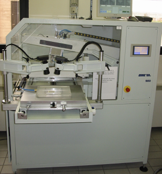Screen-stencil & roller printer
Nano to Micro/Macro (thick films and coatings production)
Screen-printing consists in forcing an ink through a screen using a plastic blade (called squeegee), in order to deposit the desired pattern onto a substrate. The ink is placed at the top of the screen, which is fixed at the edges of a frame, and the substrate is put below and kept fixed while the squeegee is moving. The screen is made of a mesh that is partially or totally open to create the geometry to be deposited, forming a sort of mould. The squeegee is moved on the screen, spreading the ink with a controlled pressure, consequently the screen undergoes a deformation that makes it touch the substrate. At the end of the printing the squeegee leaves the screen, and the pattern is deposited onto the substrate. Its thickness will be dependent on different parameters as the ink viscosity, the thickness of the screen, the snap-off distance between the screen and the substrate, the squeegee pressure etc. Once deposited, the ink is left to level in order to obtain a homogeneous layer by removing the sign of the screen. Finally, the screen-printed layers are thermally treated, an initial drying step is followed by the sintering.

Instruments datasheets


